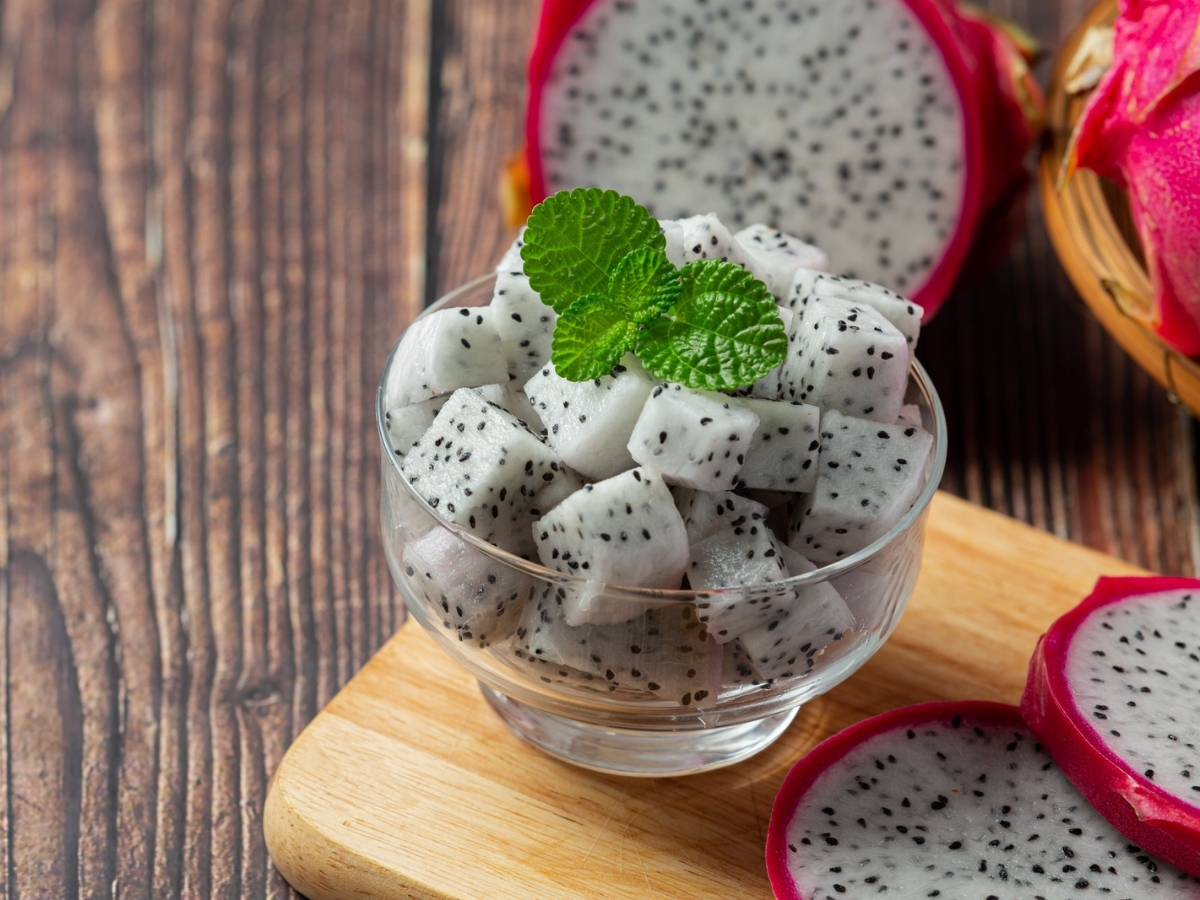Beyond its vibrant color and sweet taste, dragon fruit may offer real benefits for those managing diabetes. With its low glycemic index, high fiber content, and powerful antioxidants, dragon fruit for diabetes is gaining attention as a delicious way to help regulate blood sugar and support overall health. In this article, Natural Health explores the fruit as part of a diabetes-friendly diet.
Dragon fruit’s nutrition
Dragon fruit for diabetes also offers nutritional value, as it provides a variety of nutrients in small amounts and is a good source of iron, magnesium, and fiber. Below are the nutrition facts for a 100-gram serving:[1]
| Nutrient | Amount |
| Calories | 57 |
| Protein | 0.36g |
| Fat | 0.14g |
| Carbs | 15.23g |
| Fiber | 3.1g |
| Vitamin C | 4.3mg |
| Iron | 0.18mg |
| Magnesium | 7mg |
Dragon fruit is classified as a low glycemic index (GI) fruit, with a GI between 48 and 52.[1] Because of this, eating dragon fruit in moderation may help support better blood sugar control. This is one of the key dragon fruit benefits for diabetes, making it a smart fruit choice for people looking to manage glucose levels naturally.
Is dragon fruit good for diabetes?
Yes, dragon fruit can be a good option for people with diabetes when consumed in moderation.
Dragon fruit not only has a low to moderate GI (48–52), but it’s also rich in fiber and antioxidants. This makes dragon fruit a supportive option for maintaining better glucose control.
“Dragon fruit can be part of a diabetes-friendly diet, but like all fruits, portion control is important. Stick to moderate servings and pair with protein or healthy fats to further minimize blood sugar spikes.”

Dragon fruit benefits for diabetes
For people living with diabetes, keeping blood sugar levels stable is essential—and dragon fruit may be a helpful addition to a diabetes-friendly diet. Here’s why:
- Low Glycemic Index (GI): Dragon fruit for diabetes is a smart choice, as it has a GI of about 48–52, meaning it raises blood sugar more slowly than high-GI fruits.[1] This makes it a better option for maintaining steady glucose levels.[2]
- High in Fiber: The fiber in dragon fruit slows down sugar absorption, helping reduce spikes in blood glucose after meals, an important benefit for blood sugar management.[3]
- Rich in Antioxidants: Dragon fruit is rich in antioxidants like vitamin C and betalains.[4] These help fight oxidative stress, a harmful condition that can make diabetes worse and lead to other health problems. By reducing stress and inflammation in the body, these antioxidants make dragon fruit a healthy choice for people with diabetes.
- May Improve Insulin Sensitivity: Some studies suggest dragon fruit can help the body respond to insulin more effectively, which is especially helpful for those with type 2 diabetes dealing with insulin resistance.[2]
“Enjoying dragon fruit in moderation is one of the simple yet effective ways to tap into the key dragon fruit benefits for diabetes. Including better blood sugar control, improved insulin sensitivity, and reduced oxidative stress.”
The side effects for diabetics
Although dragon fruit is good for diabetes thanks to its low glycemic index and high fiber content, it’s important to note that rare allergic reactions have been reported. Some individuals exploring the benefits of dragon fruit for diabetes may experience symptoms such as red, itchy skin, swelling around the mouth, or intense itching after consuming the fruit or its juice. [5]
If you think you may be allergic, talk to your healthcare provider for proper testing. In case of a severe reaction, such as difficulty breathing or widespread swelling, call emergency services right away. Anaphylaxis is a serious condition that requires immediate medical attention.
Read more: Is mangosteen good for diabetes? The benefits and how to eat
How to eat dragon fruits for diabetes?
Dragon fruit can be a healthy and delicious option for people with diabetes when eaten in moderation. Here are some tips to enjoy it safely:
- Watch your portion size: Stick to about ½ cup to 1 cup (75–100 grams) per serving.[2] This keeps your sugar and carb intake in check while still benefiting from the fiber and antioxidants.
- Choose fresh fruit: Eat fresh, ripe dragon fruit instead of dried versions or juices, which may contain added sugars and a higher glycemic impact.
- Pair with protein or healthy fats: Combine dragon fruit with Greek yogurt, nuts, or seeds. This can slow digestion and help prevent blood sugar spikes.
- Monitor your blood sugar: As with any fruit, check your blood sugar after eating to see how your body responds, especially if you’re newly adding it to your diet.
- Avoid sweetened products: Skip products like dragon fruit smoothies, jams, or flavored drinks unless you’re sure they are unsweetened or sugar-free.

Frequently asked questions
How much dragon fruit should diabetics consume?
People with diabetes can enjoy around ½ to 1 cup of dragon fruit for diabetes per serving, tailored to their personal carb goals and blood sugar control needs.[2] If combining dragon fruit with other fruits, the recommended amount is about 50 grams to avoid excessive sugar intake.
Does Dragon Fruit Affect Blood Sugar?
Yes, dragon fruit can affect blood sugar, but in a generally positive way when eaten in moderation.[6]
Thanks to its low glycemic index (GI of 48–52) and high fiber content, dragon fruit is less likely to cause sharp spikes in blood sugar levels compared to high-GI fruits. The fiber slows down sugar absorption, helping support better blood glucose control.
Read also: Is banana good for diabetes? Expert Insights 2025
Is Yellow Dragon Fruit Good for Diabetes?
Yes, yellow dragon fruit can be a good option for people with diabetes, when consumed in moderation.[7] Just like the red or white varieties, yellow dragon fruit is:
- Low in calories
- Rich in fiber, which helps slow down sugar absorption
- Packed with antioxidants, including vitamin C and carotenoids that may reduce inflammation and oxidative stress linked to diabetes.
Dragon fruit isn’t just a delicious tropical fruit, it may also support better blood sugar control for people with diabetes, thanks to its low glycemic index, high fiber content, and powerful antioxidants. At Natural Health, we encourage you to listen to your body and make mindful, flexible food choices. When it comes to dragon fruit for diabetes, enjoying it in the right portions and as part of a balanced daily diet allows you to savor its natural sweetness without worrying about your blood sugar.


Last medically reviewed on
How we reviewed this article:
Reference
[1] Estimation of glycaemic index of peach palm (Bactris gasipaes) cooked fruits and chips, and pitahaya (Hylocereus spp.) pulp; Gin Jiménez, Georgina Gómez, Ana M Pérez, Adriana Blanco-Metzler; 2012
[2] Effect of dragon fruit on glycemic control in prediabetes and type 2 diabetes: A systematic review and meta-analysis; Nalinee Poolsup, Naeti Suksomboon, Naw Juna Paw; 2017
[3] Dragon Fruit Juice Reduces Blood Sugar Levels in Diabetes Mellitus Clients; Muhamad Jauhar; 2024
[4] Anti-Inflammatory, Antioxidant, and Other Health Effects of Dragon Fruit and Potential Delivery Systems for Its Bioactive Compounds; Daniela Franceschi Nishikito, Ana Claudia Abdalla Borges, Lucas Fornari Laurindo, Alda M M Bueno Otoboni, Rosa Direito, Ricardo de Alvares Goulart, Claudia C T Nicolau, Adriana M R Fiorini, Renata Vargas Sinatora, Sandra M Barbalho; 2023
[5] Anaphylactic reaction to (mixed) fruit juice containing dragon fruit; Andreas Kleinheinz, MDa, Ute Lepp, MDb, Björn M. Hausen, MDa ∙ Arnd Petersen, PhDc, Wolf-Meinhard Becker, PhD; 2009
[6] Dragon Fruit – Health Benefits, Nutrition, and How to Include It in Your Diet; Apollo Hospitals; 2025
[7] From Weight Loss To Digestion: Here are 7 Benefits Of Yellow Dragon Fruit You Should Not Miss; Sushmita Sharma; 2025
Share this article
Read this next
Is water lemon good for diabetes? What should you know
Lemon water is good for diabetes, not just because it’s refreshing, but because it offers real support for blood sugar control. With zero added sugar, rich in vitamin C and antioxidants, it may help improve hydration, aid digestion, and reduce post-meal blood sugar spikes. At Natural Health, we break down how to make lemon water…
Apple cider vinegar for diabetes: The research says and tips to use
At Natural Health, we explore the growing interest in apple cider vinegar for diabetes. Studies suggest it may help improve insulin sensitivity and lower blood sugar levels after meals. This article explains how apple cider vinegar works, how to use it safely, and what people with diabetes need to know before adding it to their…
Is sweet corn good for diabetes? Dietitians explain
At Natural Health, we know many people managing blood sugar often ask, is sweet corn good for diabetes? The short answer: YES, with the right portion. Corn contains fiber, vitamins, and antioxidants that support overall health. In this guide, we break down how corn fits into a diabetes-friendly diet and how to enjoy it without…